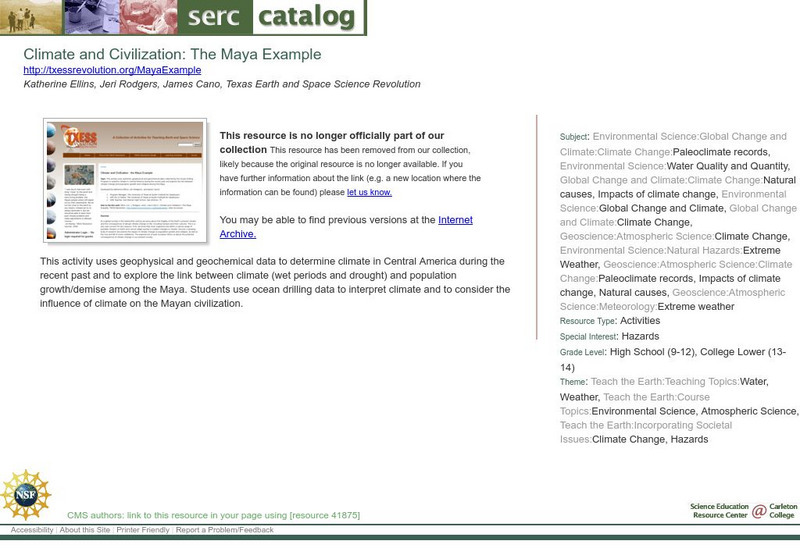Curated OER
Pocumtucks In Deerfield
Young scholars read a story about the Pocumtucks' religious beliefs. Using the text, they discover their concept of land ownership and how they migrated within their territory in different seasons. They use primary and secondary...
Curated OER
Glasgow - A Case Study 1
Students comprehend the reasons for poor housing in Glasgow in the 1940's. They discuss the conditions experienced by tenement residents and analyze the re-development proposals put forward by the city corporation. Students view "Glasgow...
Curated OER
Home on the Range
Middle schoolers use maps and mathematics to determine the appropriate panther population in a given area. In this Florida ecology lesson, students research the area requirements of male and female panther and use a map to help calculate...
Curated OER
Digital Video Lesson Plan: Brine Shrimp
Students participate in classroom experiment to gain better understanding of type of environment brine shrimp can best survive. Students then explore effects of common saltwater pollutants on survival of animals in sea.
Curated OER
Chernobyl
High schoolers list some of the health effects of radiation exposure. They are engaged in a unit on nuclear power by demonstrating the potential environmental health risks involved.
Curated OER
Development, Trade, Aid
Twelfth graders study the term development. In this Economics lesson, 12th graders explore the role of trade in stimulating development, with particular focus on the role played by the British Government. Students decide how aid...
Curated OER
Arsenic Globally
Students, using directed questions, identify five internet resources. They use these resources to identify relevant information by highlighting those sections that address the provided questions. Students present the answers to these...
Curated OER
Dissolved Oxygen in an Aquatic Ecosystem
Students explain why dissolved oxygen is important in aquatic ecosystems. They evaluate the optimal dissolved oxygen levels for living organisms.
Curated OER
San Francisco Explodes
High schoolers investigate why San Francisco grew so quickly during the Gold Rush. They
Curated OER
Endangered Spaces = Endangered Species!
Sixth graders discuss the crowding, loss of personal space, loss of home, loss of food, etc. that might occur at a developmental site. They witness, through an in-class demonstration, what happens when land is taken for development. They...
Curated OER
Country Research
Sixth graders research a given country using teacher selected websites. They gather notes about their country in an organized manner. They then create a PowerPoint including a reference page displaying the information they gathered.
Curated OER
Humane Science Projects
In this science learning exercise, students examine the list of possible science projects. They look for the characteristics that set apart these ideas as humane.
Curated OER
Houghton Mifflin Social Studies/Chapter 8, Lesson 1: Farming Takes Hold (pp. 184-187)
Fourth graders discuss that the movement toward farming during the 1850's to the 1870's meant for California. The economy of California is studied in relationship to the effects of farming. There are several focus questions to help...
TeachEngineering
Teach Engineering: Population Growth Curves
Using Avida-ED freeware, students control a few factors in an environment populated with digital organisms, and then compare how changing these factors affects population growth. They experiment by altering the environment size (similar...
The Association of the British Pharmaceutical Industry
Abpi: Population Growth
Students control the environments in four different scenarios to discover how any changes might affect populations. The different simulations include microorganisms, rabbits, foxes, and other organisms.
National Humanities Center
National Humanities Center: Teacher Serve: Choosing Future Population
Essay on population growth past, present and future and the impact on society. Includes guiding questions for students and links to related resources.
Center for Innovation in Engineering and Science Education, Stevens Institute of Technology
Ciese: Population Growth Project
In this collection of nine lessons, students use data from the U.S. Census to create population growth models and to examine the impact of changes in population factors such as age, demographic, etc.
Geographypods
Geographypods: Patterns and Change: Patterns in Resource Consumption
This collection of three learning modules looks at issues related to resource consumption. It examines theories about how population size affects consumption, the changing patterns of energy consumption, and ways to minimize consumption....
Other
Texas Population Growth, Projections, and Implications [Pdf]
A report analyzing the population changes that have occurred in Texas since the middle of the 20th century, and the expected projections for the future. It breaks the numbers down by race and ethnicity to show that Hispanics will...
Geographypods
Geographypods: Theme 1: Population and Settlement
A rich collection of highly engaging learning modules on topics related to population and settlement. Covers six main areas - population growth, population change, population migration, land use, settlement characteristics and patterns,...
US Census Bureau
Population Pyramids
Visual representations of population distribution by age and sex for any country.
Climate Literacy
Clean: Climate and Civilization: The Maya Example
Students use geophysical and geochemical data collected by the Ocean Drilling Program to examine climate in Central America during the recent past. They also have the opportunity to investigate the link between climate change and...
US Census Bureau
U.s. Census Bureau: Population Change and Distribution [Pdf]
This U.S. Census Web site gives current and past information on population changes and distribution. Must have an Adobe Reader to access.
Polk Brothers Foundation Center for Urban Education at DePaul University
De Paul University: Center for Urban Education: Changing the Ecosystem: Q & a [Pdf]
"Changing the Ecosystem: Q & A" is a one page, nonfiction, reading passage about how the loss of the prairie to farming and population growth impacts the ecosystem. It is followed by questions which require students to provide...




















